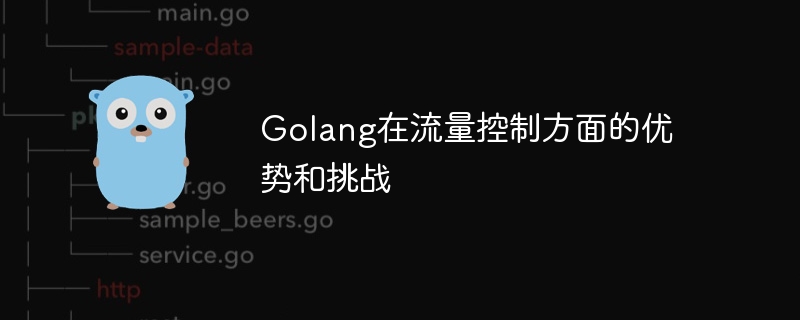Home >Backend Development >Golang >Golang's advantages and challenges in traffic control
Golang's advantages and challenges in traffic control
- PHPzOriginal
- 2024-03-06 17:39:041140browse

Golang is a programming language with high development efficiency and superior performance, which performs well when handling high concurrency and large-scale traffic. This article will explore the advantages and challenges of flow control in Golang and provide specific code examples to illustrate its application.
1. Golang’s advantages in flow control
- Concurrency model: Golang uses lightweight thread goroutine to handle concurrency. Each goroutine only occupies a small amount of stack space and can be efficient Start, destroy and schedule locally. This concurrency model makes Golang very suitable for handling large-scale concurrent requests and can easily cope with high-concurrency flow control requirements.
- Channel communication: In Golang, goroutines communicate through Channel. This mechanism is simple and efficient. Using Channel, data transmission and synchronization between different goroutines can be realized, which facilitates control operations such as traffic limiting and speed limiting.
-
Built-in library support: Golang's standard library provides rich concurrency control tools, such as mutexes, semaphores, etc. in the sync package, and the context package is used to pass request-range values and cancel. Signal. These tools can help developers quickly implement flow control functions.

2. Golang’s challenges in flow control
- Concurrency security: in high concurrency In this scenario, ensuring data consistency and security is a challenge. Developers need to pay attention to concurrent access control between goroutines to avoid problems such as data competition and memory leaks.
- Debugging and optimization: Due to the concurrent execution of goroutines, debugging and optimization of flow control may be more complicated. Developers need to master Golang debugging tools, such as pprof and trace, in order to quickly locate and solve performance bottlenecks.
- Algorithm design: When performing flow control, it is necessary to design an appropriate algorithm to implement requested current limiting, rate limiting and other functions. Developers need to deeply understand the principles of flow control, choose appropriate algorithms and implement them in Golang.
3. Code Example
The following is a simple example to show how to implement the rate limiting function based on the Token Bucket algorithm in Golang:
package main
import (
"fmt"
"time"
)
func tokenBucket(rateLimit time.Duration, capacity int) <-chan struct{} {
tokens := make(chan struct{}, capacity)
go func() {
ticker := time.NewTicker(rateLimit / time.Duration(capacity))
defer ticker.Stop()
for range ticker.C {
select {
case tokens <- struct{}{}:
default:
}
}
}()
return tokens
}
func main() {
rateLimit := 1 * time.Second
capacity := 3
tokens := tokenBucket(rateLimit, capacity)
for i := 0; i < 5; i++ {
<-tokens
fmt.Printf("Request %d processed
", i+1)
time.Sleep(500 * time.Millisecond)
}
}The above code A tokenBucket function is defined to simulate the rate limiting function of the Token Bucket algorithm. In the main function, a token bucket with a rate of 1 time/second and a capacity of 3 is created by calling the tokenBucket function. In each loop, the program obtains tokens from the token bucket, simulates the processing of the request, and simulates the request interval through time.Sleep.
The above code example shows how to implement a simple flow control function in Golang, helping developers better understand the advantages and challenges of Golang in flow control.
Summary: Golang has obvious advantages when dealing with large-scale traffic and concurrency, but it also faces some challenges. By making full use of Golang's concurrency model, Channel communication and built-in library support, combined with appropriate algorithm design, developers can efficiently implement flow control functions. In practical applications, it is recommended that developers deeply understand the concurrency characteristics of Golang and flexibly use various tools and technologies to better cope with complex flow control requirements.
The above is the detailed content of Golang's advantages and challenges in traffic control. For more information, please follow other related articles on the PHP Chinese website!


